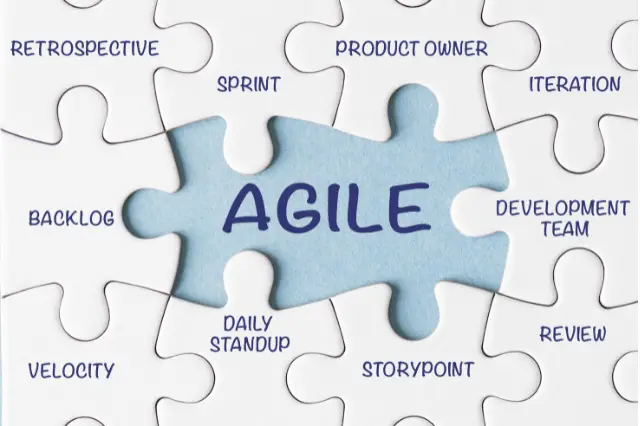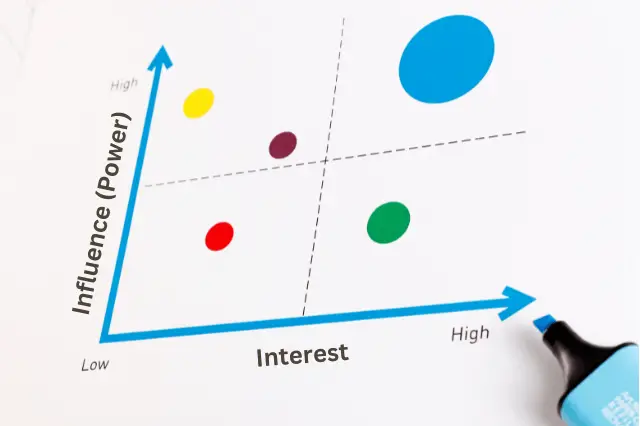Last Updated on March 23, 2024 by andrewshih
Understanding Work Breakdown Structure is not only important for the PMP exam, but it is also a very useful tool to master for your project management career.
This article will help you understand what Work Breakdown Structure is. We will cover the high-level before we dive into the details.
First, we will explain what is WBS in project management and how they are related. Then we will take a closer look at what WBS is and share several WBS Examples.
Next, we will explain the benefits of WBS and common types of WBS. Then we will take a deep dive to cover the hierarchy, various WBS elements, and the format of WBS. Finally, we share a few popular software for creating the WBS.
Let’s get started.
What is WBS in Project Management
When it comes to planning a project, one should understand:
- The purpose of the project
- Complexity and type of the project
- The end result or the output
All the above can be followed from the given project charter, which is the key input for the project team to plan the project. It is not advisable to start any project without a charter in hand.
The charter shed lights on:
Total work or effort needed to complete or accomplish the project.
The total work we refer to as “project scope” needs to be disintegrated or broken down into smaller and manageable work units to execute efficiently. These work units are distributed/assigned to the respective team members.
The process of breaking down the total scope into smaller, manageable work units creates a “Work Breakdown Structure” (WBS).
With the brief intro about WBS above, let’s define WBS.
What is Work Breakdown Structure (WBS):
Definition of WBS
As defined by PMI-PMBOK, Work Breakdown Structure (WBS) is:
A hierarchical decomposition of the total scope of work to be carried out by the project team to accomplish the project objectives and create the required deliverables.
WBS and Project Scope Decomposition
Each descending level of the WBS represents an increasingly detailed definition of the project work.
WBS emphasizes making large or complex projects into smaller, more manageable units.
WBS decomposes the total project scope into smaller tasks that are measurable. Different team members can simultaneously execute the tasks, thus improving team productivity and project management.
The project manager with his/her team is responsible for creating the WBS of the assigned project.
The total high-level project objective (also called “deliverable”) listed in the project charter is divided into smaller and measurable units/tasks. These units are “Work Packages.”
The project scope is divided until it reaches a level from which it cannot be dissected further and can be managed by a single resource.
The division follows the 8/80 rule, which states that the duration of the work packages needs to be between 8 hours/day and 80 hours/tasks or units. The division also ensures that nothing is missing (Scope Creep) from the accepted project scope.
To summarize:
WBS represents the TOTAL SCOPE of the project.
WBS, Project Duration, and Cost
Since the project scope is divided into smaller work packages, the sum of the durations or costs of these work packages would be added together to, in a reverse way, arrive at the total duration or cost of the project.
In project management, this is “bottom-up” estimating.
With this, we can understand that WBS helps calculate the project duration (schedule) and cost (budget).
Hence, the accuracy of the project schedule and the budget depends mainly on the accuracy level of the WBS. This increases the likelihood of completing the project successfully within constraints.
Additionally, WBS in project management is an effective planning tool for:
- Risk Management Plan
- Resource Breakdown Structure
- Status Reports
Work Breakdown Structure Examples
Now that you understand WBS and its relationship with project management let’s look at several examples.
The first example shows a general view of a work breakdown structure with a hierarchy:
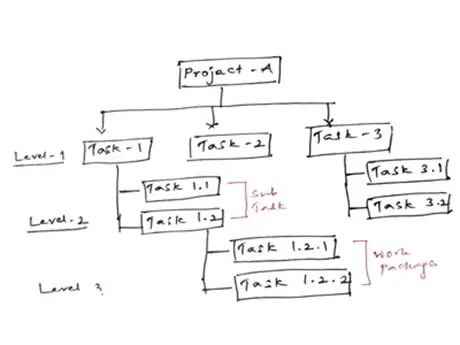
Here is an example of a WBS for a construction project in a spreadsheet.
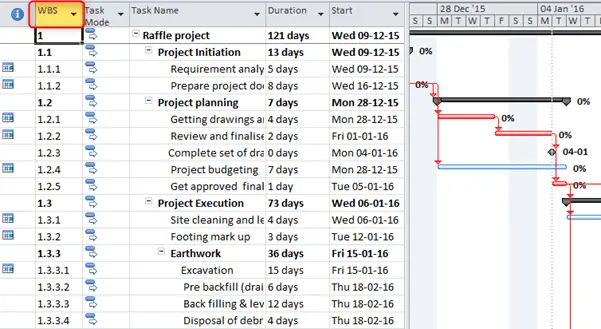
Here is a WBS example for a software project:
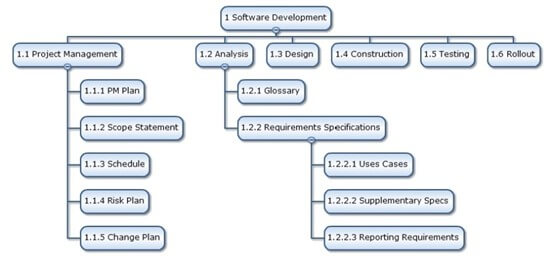
Why does Project management need WBS?
Project managers know that there are many things/tasks to complete before the final product/service delivery.
In a complex project, many things may go wrong OR slip, no matter how experienced the project team is. An effective/detailed WBS can resolve such a problem.
A detailed and complete WBS ensures the project’s success. At any point in time, WBS helps trace missed tasks, cost overruns, and schedule deviations.
Some of the key benefits of WBS are as follows:
- The visual representation helps understand the whole process of meeting the project outcome.
- Breaks the entire work into smaller and more manageable work units.
- Ensures intended and measurable results.
- Helps in monitoring the progress at any stage of the project.
- Ensures “No gold plating” (adding additional work beyond the agreed scope). Prevents scope creep.
- Assists in creating projects schedule and budget
- Assists in resource allocation based on the individual skill set.
Types of WBS
Based on the nature of the project carried out (simple or complex), the project can be decomposed and represented using several types of WBS, including project phase, deliverables, and team responsibilities:
Phase Based
With a phase-based approach, WBS and scope are prepared and elaborated phase-wise. Phase-based WBS is ideal for a project that is planned and executed in a phased manner. The output from the previous phase can be added to the next phase of work.
E.g., the Construction of a House
For example, the construction of a house may have the following phases:
- Design
- Procurement
- Construction
- Inspections
- Handover
Each phase involves a subset of activities/tasks.
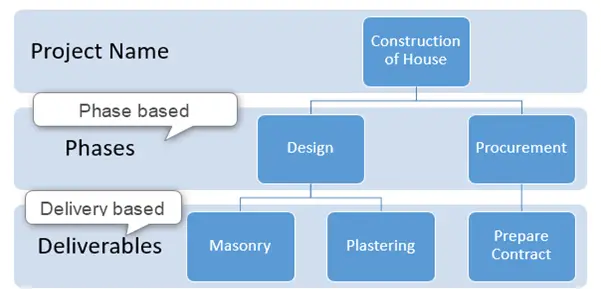
Deliverable Based
This type of WBS is prepared for each deliverable, either for part or for the whole project. In the above example, the construction phase has deliverables like:
- Masonry work
- Internal plastering
- External plastering
- Painting
Each deliverable is still associated with smaller tasks to accomplish the work.
Responsibility Based
This type of WBS represents the people/team assigned to any particular task/work.
Using the same example above, the construction project has different people/departments to carry out or manage different tasks or works.
For example:
- Design Team
- Procurement Team
- Construction Team
- Inspection (Quality) Team
- Handover (maintenance/operations) Team
Hierarchy of Work Breakdown Structure
A typical work breakdown structure has 3 to 4 WBS levels. These are as follows:
Project Name
At Zero level shows the project’s title, including the final deliverable.
E.g., the Construction of a House
WBS Dictionary
Though this does not specify any level in the WBS hierarchy, this is a key element in WBS. WBS dictionary is a document that provides detailed information related to each element in WBS.
WBS dictionary generally includes brief information on the scope or statement of work, defined deliverables, a list of associated activities, and milestones pertaining to the task.
See the figure below.
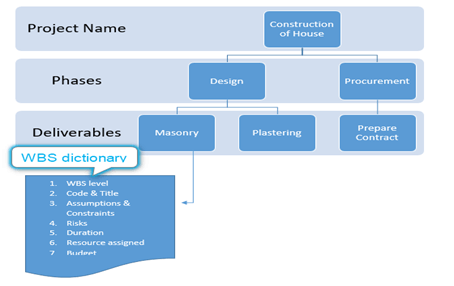
Control Account
A control account is a management tool where budgets and actual costs accumulate along with the project schedule. This is measured against the project scope while carrying out Earned Value Analysis for management-related reports.
Planning Package
Planning packages are created within a control account that is expected to occur in the future. This is the component of WBS below the control account and above the work package with known content but without detailed scheduled activities.
The planning package is the known work but not scheduled or assigned to any resource.
As its name suggests, planning packages still require additional planning before turning them into work packages.
When the project scope is elaborated, more planning packages get converted to Work Packages.
Work Package
A work package is the lowest level of WBS.
Hence, the work package is a set of activities performed to get an output at that level. Essentially work package is a well-defined task that can be completed and measured with cost, schedule, and resource information.
A control account has multiple work packages, each associated with a single control account. Work packages are the subdivisions and the lowest level of the control account.
Elements of Work Breakdown Structure
A typical WBS for any given project depicts the total scope of that project.
The outcome/deliverable of the project, when completed, must possess all the characteristics and properties agreed upon at the project’s initiation. Else the project becomes a failure.
Hence, irrespective of the format we use for creating the WBS, one must (project manager) understand the components of a WBS.
One can state that “WBS includes all the work but only the work.” This means it includes only the agreed scope and nothing else.
So, knowing what is and not to be included in the WBS is imperative.
Following are the general guidelines any project team needs to follow while creating a WBS.
Hierarchy Level
WBS starts with the project name, followed by high-level deliverables, which proceed to work packages.
All the activities/tasks at the subsequent WBS levels are smaller than the activities/tasks at the level above. Each work package is independent and can be defined clearly and estimated both in terms of duration and cost.
Here is a WBS example with hierarchy:

Deliverables or Products
Each work package in a WBS is a deliverable that contributes to the final product or output.
Deliverables at each level
While WBS delivers the total project output, it is important to know that each level in WBS delivers part of the final product or output.
So, WBS at level must include deliverables at each level. It helps to ensure that there are no overlaps in the deliverables.
Duration in hours per deliverable
WBS at each level and for each work package should show the time required to complete each level and the total time.
Cost per deliverable
In order to arrive at the project budget, each work package at each level of the WBS should be assigned with cost per deliverable. The costs will be rolled over to the higher level to arrive at the project budget.
Formats of WBS
- Flow charts: useful for depicting workflow in sequence
- Spreadsheets-used for complex projects to show detailed information, data, and dependencies
- Outlines: Useful for smaller and simple projects to list “to-dos”
- Gantt Charts: WBS can be structured as a Gantt chart that combines both spreadsheets and the timeline. With the Gantt chart, you can show dependencies between the tasks and the project timeline.
WBS Software
Various software exists in the global market that is used to create different types of WBS for different types of projects. Here is a list of a few of the popular software for creating work breakdown structures:
- Project manager: A cloud-based WBS software that offers simple and powerful project management tools for the project manager and team members.
- EdrawMax: Offers a wide range of pre-designed templates for creating WBS.
- Microsoft Project: This is also very popular and powerful software used by many organizations
- Lucidchart
- SmartDraw
- Visual Paradigm
- Matchware
- Craetly
Conclusion
Work Breakdown Structure is a powerful tool for planning any type of project of varied complexity. The accuracy of the WBS depends on the project manager and the team involved.
WBS is very helpful in tracking the cost, schedule, scope, and quality of the deliverables. WBS can be used throughout the project management life cycle.
References:
- Building a Project Work Breakdown Structure: Visualizing Objectives, Deliverables, Activities, and Schedules by Dennis P. Miller, PMP
- PMP Exam Prep, by Rita Mulcahy
- PMI-PMBoK, 6th Edition.
- Project Management, a Systems Approach to Planning, Scheduling and Controlling, by Harold Kerzner, 12th Edition.

